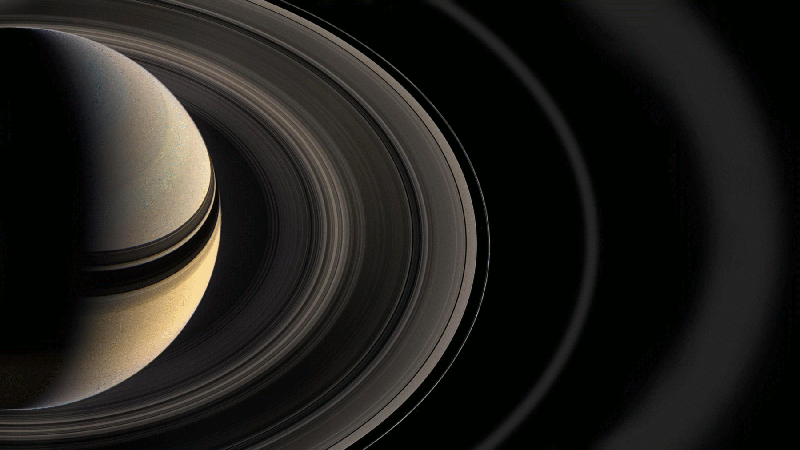November 30, 2016
NASA’s Cassini probe is nearing the end of its lifetime, and the little spacecraft is going out with a bang. Today, the spacecraft begins a series of 20 “ring-grazing” orbits, bringing Cassini the closest it’s ever been to Saturn’s vast, majestic discs of ice and dust.
Since 2004, Cassini has been touring the gas giant Saturn, its rings, and its many moons. The mission has revealed unexpected wonders, from geysers on Enceladus to flowing liquid methane on Titan to a mysterious, color-changing hexagon at Saturn’s north pole. While NASA would probably be happy if Cassini could keep buzzing around Saturn snapping photos forever, the spacecraft is running precariously low on fuel. One way or another, the end is approaching.
Next September, Cassini will make a suicide plunge into Saturn’s atmosphere. But until then, the spacecraft still has a lot of work to do. From today until April 22nd, Cassini will circle over and under Saturn’s poles, in an elliptical orbit inclined about 60 degrees from the ring plane. Once a week, it’ll swoop down to cross that plane just outside Saturn’s F ring, a narrow band that’s considered the outer extent of main ring system.

Cassini will pass this unexplored ring edge a total of 20 times, at a distance of less than 5,000 miles (8,000 kilometers).
“We’re calling this phase of the mission Cassini’s Ring-Grazing Orbits, because we’ll be skimming past the outer edge of the rings,” Cassini project scientist Linda Spilker said in a statement. “In addition, we have two instruments that can sample particles and gases as we cross the ringplane, so in a sense Cassini is also ‘grazing’ on the rings.”
During the ring-grazing orbits, Cassini will build up a high-resolution snapshot of the rings’ structures. While Saturn’s rings are thousands of miles wide, they are, astonishingly, less than mile thick. If you were holding a scale toy model of Saturn, those rings would be 100 times thinner than a sheet of printer paper. Cassini will resolve details in these virtually 2-D structures down to less than 0.6 miles (1 km) per pixel.
The next 20 weeks will also afford Cassini the opportunity to snap our best photos yet of four tiny Saturnian moons: Pandora, Atlas, Pan and Daphnis. Each of these moons is just a few miles in diameter, too small to form a spherical shape under its own gravity. Nevertheless, the moons’ tiny gravitational tugs shape and sculpt ring structure, and their composition may offer clues as to how the rings first formed.
After the ring-grazing orbits, Cassini’s schedule only gets more action-packed. In April, the spacecraft begins its swan song, a “Grand Finale” that brings it just 1,000 miles (1600 km) above Saturn’s cloud tops and sends it on dizzying dives through the narrow gap between the gas giant and its rings. And on September 15th, Cassini will execute its final maneuver, plunging into Saturn’s atmosphere. The spacecraft will ll burn up and break apart, its molecules dispersing far and wide into the blustery ball of gas that it’s spent the last decade-and-a-half studying.
Cassini is harnessing a gravitational kick from Titan to set it on its ring-grazing path later today. During the first F ring crossing on December 4th, Cassini will make a nine-hour movie of Saturn’s tempestuous north pole, and snap a few money shots of the icy geysers at Enceladus’ south pole.
For anyone interested in following the latest chapter in Cassini’s journey, NASA has a wealth of information available online, including a full list of dates and times associated with each ring-grazing orbit, highlights of the different orbits, and detailed summaries of the science in the weeks to come.
Source:
http://gizmodo.com/cassini-spacecraft-begins-dramatic-ring-grazing-orbits-1789513946